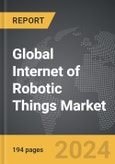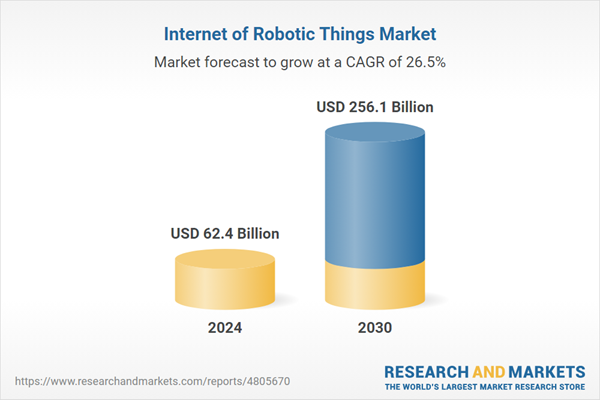The global market for Internet of Robotic Things was valued at USD 62.4 Billion in 2024 and is projected to reach USD 256.1 Billion by 2030, growing at a CAGR of 26.5% from 2024 to 2030. This comprehensive report provides an in-depth analysis of market trends, drivers, and forecasts, helping you make informed business decisions.
Global Internet of Robotic Things Market - Key Trends & Drivers Summarized
What Is the Internet of Robotic Things and Why Is It Redefining Automation?
The Internet of Robotic Things (IoRT) refers to the integration of robotics with the Internet of Things (IoT), creating an interconnected network of intelligent devices capable of sensing, processing, and communicating data. These robotic devices are not only able to perform tasks autonomously but can also interact with other machines, systems, and environments in real-time, making automation more dynamic and adaptable. IoRT is redefining automation by enabling robots to make decisions based on real-time data and coordinate with other systems for more complex operations. This convergence of robotics and IoT is finding applications across various industries, including manufacturing, healthcare, logistics, and smart homes, where it is driving significant advancements in efficiency, precision, and flexibility.How Are Technological Advancements Shaping the Internet of Robotic Things Market?
Technological advancements are playing a critical role in shaping the Internet of Robotic Things market, particularly through innovations in artificial intelligence (AI), machine learning, and sensor technology. The integration of AI and machine learning into robotic systems is enhancing their ability to analyze data, learn from experiences, and make decisions autonomously. This allows robots to adapt to changing environments and optimize their performance without human intervention. Advances in sensor technology are also expanding the capabilities of IoRT devices by improving their ability to perceive and interact with their surroundings. Sensors such as LIDAR, cameras, and RFID are enabling robots to navigate complex environments, identify objects, and even collaborate with other machines. Additionally, the development of 5G connectivity is providing the high-speed, low-latency communication required for real-time data exchange between robotic devices and other systems, further driving the adoption of IoRT across various sectors.Why Is There an Increasing Demand for the Internet of Robotic Things in Various Industries?
The demand for the Internet of Robotic Things is increasing across various industries due to the growing need for automation, efficiency, and precision in operations. In manufacturing, IoRT is being leveraged to create smart factories where robotic systems work alongside humans and other machines to streamline production processes, reduce downtime, and improve product quality. The healthcare industry is also adopting IoRT for applications such as remote surgery, robotic-assisted rehabilitation, and automated patient care, where precision and real-time data are critical. The logistics sector is utilizing IoRT to optimize supply chain operations through automated warehousing, inventory management, and last-mile delivery solutions. Additionally, the rise of smart homes and cities is driving the integration of IoRT in consumer products, where robots perform tasks ranging from cleaning and security to elder care and personal assistance. As industries continue to embrace digital transformation, the demand for IoRT is expected to grow, driven by the need for more intelligent and interconnected robotic systems.What Factors Are Driving the Growth in the Internet of Robotic Things Market?
The growth in the Internet of Robotic Things market is driven by several factors closely tied to technological advancements, industry trends, and the increasing complexity of modern operations. One of the primary drivers is the rising adoption of AI and machine learning in robotics, which is enabling more sophisticated and autonomous robotic systems capable of real-time decision-making. The expanding applications of IoRT in industries such as manufacturing, healthcare, and logistics are also fueling market growth, as these sectors seek to enhance efficiency, reduce costs, and improve outcomes through automation. The development of advanced sensor technologies and high-speed connectivity solutions, such as 5G, is further propelling the market by enabling more seamless and reliable interactions between robotic devices and other systems. Additionally, the growing emphasis on smart infrastructure and the rise of Industry 4.0 are creating new opportunities for IoRT, as businesses look to integrate robotics with IoT to create more responsive and adaptive environments. As these trends continue to shape the market, the Internet of Robotic Things is expected to experience sustained growth, driven by the need for more intelligent, connected, and autonomous systems across a wide range of applications.Report Scope
The report analyzes the Internet of Robotic Things market, presented in terms of market value (USD Thousand). The analysis covers the key segments and geographic regions outlined below.Segments
Service (Professional, Managed); Platform (Device Management, Application Management, Network Management); Application (Service Sectors, Collaborative Industrial Robots, Other Applications).Geographic Regions/Countries
World; United States; Canada; Japan; China; Europe (France; Germany; Italy; United Kingdom; and Rest of Europe); Asia-Pacific; Rest of World.Key Insights:
- Market Growth: Understand the significant growth trajectory of the Professional Service segment, which is expected to reach $167.9 Billion by 2030 with a CAGR of a 27.1%. The Managed Service segment is also set to grow at 25.6% CAGR over the analysis period.
- Regional Analysis: Gain insights into the U.S. market, valued at $18.5 Billion in 2024, and China, forecasted to grow at an impressive 25.5% CAGR to reach $38.3 Billion by 2030. Discover growth trends in other key regions, including Japan, Canada, Germany, and the Asia-Pacific.
Report Features:
- Comprehensive Market Data: Independent analysis of annual sales and market forecasts in USD from 2024 to 2030.
- In-Depth Regional Analysis: Detailed insights into key markets, including the U.S., China, Japan, Canada, Europe, Asia-Pacific, Latin America, Middle East, and Africa.
- Company Profiles: Coverage of major players such as ABB Group, Aethon, Inc., Amazon.com, Inc., Cisco Systems, Inc., ECA Group and more.
- Complimentary Updates: Receive free report updates for one year to keep you informed of the latest market developments.
Why You Should Buy This Report:
- Detailed Market Analysis: Access a thorough analysis of the Global Internet of Robotic Things Market, covering all major geographic regions and market segments.
- Competitive Insights: Get an overview of the competitive landscape, including the market presence of major players across different geographies.
- Future Trends and Drivers: Understand the key trends and drivers shaping the future of the Global Internet of Robotic Things Market.
- Actionable Insights: Benefit from actionable insights that can help you identify new revenue opportunities and make strategic business decisions.
Key Questions Answered:
- How is the Global Internet of Robotic Things Market expected to evolve by 2030?
- What are the main drivers and restraints affecting the market?
- Which market segments will grow the most over the forecast period?
- How will market shares for different regions and segments change by 2030?
- Who are the leading players in the market, and what are their prospects?
Some of the 42 major companies featured in this Internet of Robotic Things market report include:
- ABB Group
- Aethon, Inc.
- Amazon.com, Inc.
- Cisco Systems, Inc.
- ECA Group
- FANUC Corporation
- Gecko Systems Intl. Corporation
- Google LLC
- Honda Motor Co., Ltd.
- Intel Corporation
- iRobot Corporation
- KUKA AG
- Northrop Grumman Corporation
- Omron Adept Technologies, Inc.
- Robert Bosch GmbH
- Samsung Electronics Co., Ltd.
- Yaskawa Electric Corporation
Table of Contents
I. METHODOLOGYII. EXECUTIVE SUMMARY2. FOCUS ON SELECT PLAYERSIII. MARKET ANALYSISIV. COMPETITION
1. MARKET OVERVIEW
3. MARKET TRENDS & DRIVERS
4. GLOBAL MARKET PERSPECTIVE
UNITED STATES
CANADA
JAPAN
CHINA
EUROPE
FRANCE
GERMANY
ITALY
UNITED KINGDOM
REST OF EUROPE
ASIA-PACIFIC
REST OF WORLD
Companies Mentioned (Partial List)
A selection of companies mentioned in this report includes, but is not limited to:
- ABB Group
- Aethon, Inc.
- Amazon.com, Inc.
- Cisco Systems, Inc.
- ECA Group
- FANUC Corporation
- Gecko Systems Intl. Corporation
- Google LLC
- Honda Motor Co., Ltd.
- Intel Corporation
- iRobot Corporation
- KUKA AG
- Northrop Grumman Corporation
- Omron Adept Technologies, Inc.
- Robert Bosch GmbH
- Samsung Electronics Co., Ltd.
- Yaskawa Electric Corporation
Table Information
| Report Attribute | Details |
|---|---|
| No. of Pages | 194 |
| Published | April 2025 |
| Forecast Period | 2024 - 2030 |
| Estimated Market Value ( USD | $ 62.4 Billion |
| Forecasted Market Value ( USD | $ 256.1 Billion |
| Compound Annual Growth Rate | 26.5% |
| Regions Covered | Global |









